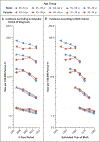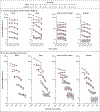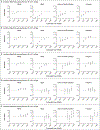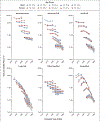Higher Lung Cancer Incidence in Young Women Than Young Men in the United States
- PMID: 29791813
- PMCID: PMC7717174
- DOI: 10.1056/NEJMoa1715907
Higher Lung Cancer Incidence in Young Women Than Young Men in the United States
Abstract
Background: Previous studies showed a higher incidence of lung cancer among young women than among young men in the United States. Whether this pattern has continued in contemporary birth cohorts and, if so, whether it can be fully explained by sex differences in smoking behaviors are unknown.
Methods: We examined the nationwide population-based incidence of lung cancer according to sex, race or ethnic group, age group (30 to 34, 35 to 39, 40 to 44, 45 to 49, and 50 to 54 years), year of birth (1945 to 1980), and calendar period of diagnosis (1995-1999, 2000-2004, 2005-2009, and 2010-2014), and we calculated female-to-male incidence rate ratios. We also examined the prevalence of cigarette smoking, using data from the National Health Interview Survey from 1970 to 2016.
Results: Over the past two decades, the age-specific incidence of lung cancer has generally decreased among both men and women 30 to 54 years of age in all races and ethnic groups, but the declines among men have been steeper. Consequently, among non-Hispanic whites, the female-to-male incidence rate ratios increased, exceeding 1.0 in the age groups of 30 to 34, 35 to 39, 40 to 44, and 45 to 49 years. For example, the female-to-male incidence rate ratio among whites 40 to 44 years of age increased from 0.88 (95% confidence interval [CI], 0.84 to 0.92) during the 1995-1999 period to 1.17 (95% CI, 1.11 to 1.23) during the 2010-2014 period. The crossover in sex-specific rates occurred among non-Hispanic whites born since 1965. Sex-specific incidence rates converged among non-Hispanic blacks, Hispanics, and non-Hispanic Asians and Pacific Islanders but crossed over from a higher incidence among men to a higher incidence among women only among Hispanics. The prevalence of cigarette smoking among women born since 1965 has approached, but generally not exceeded, the prevalence among men.
Conclusions: The patterns of historically higher incidence rates of lung cancer among men than among women have reversed among non-Hispanic whites and Hispanics born since the mid-1960s, and they are not fully explained by sex differences in smoking behaviors. Future studies are needed to identify reasons for the higher incidence of lung cancer among young women. (Funded by the American Cancer Society.).
Figures





Comment in
-
Incidence of Lung Cancer among Young Women.N Engl J Med. 2018 Sep 6;379(10):988. doi: 10.1056/NEJMc1808250. N Engl J Med. 2018. PMID: 30188632 No abstract available.
-
Incidence of Lung Cancer among Young Women.N Engl J Med. 2018 Sep 6;379(10):988. doi: 10.1056/NEJMc1808250. N Engl J Med. 2018. PMID: 30188633 No abstract available.
-
Incidence of Lung Cancer among Young Women.N Engl J Med. 2018 Sep 6;379(10):988-9. doi: 10.1056/NEJMc1808250. N Engl J Med. 2018. PMID: 30188635 No abstract available.
-
Sex disparities in lung cancer incidence: validation of a long-observed trend.Transl Lung Cancer Res. 2019 Aug;8(4):543-545. doi: 10.21037/tlcr.2019.04.06. Transl Lung Cancer Res. 2019. PMID: 31555528 Free PMC article. No abstract available.
References
-
- Siegel RL, Jacobs EJ, Newton CC, et al. Deaths due to cigarette smoking for 12 smoking-related cancers in the United States. JAMA Intern Med 2015;175:1574–6. - PubMed
-
- Siegel RL, Miller KD, Jemal A. Cancer statistics, 2018. CA Cancer J Clin 2018;68: 7–30. - PubMed
-
- Jemal A, Travis WD, Tarone RE, Travis L, Devesa SS. Lung cancer rates convergence in young men and women in the United States: analysis by birth cohort and histologic type. Int J Cancer 2003;105:101–7. - PubMed
Publication types
MeSH terms
Grants and funding
LinkOut - more resources
Full Text Sources
Other Literature Sources
Medical
Miscellaneous
